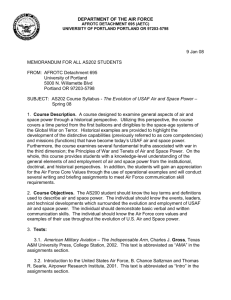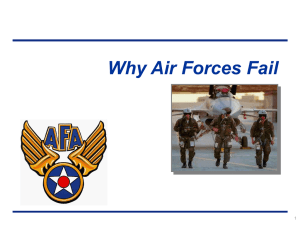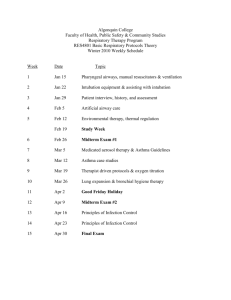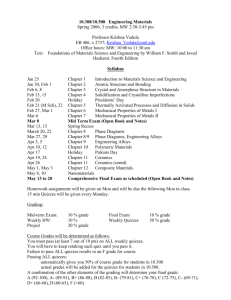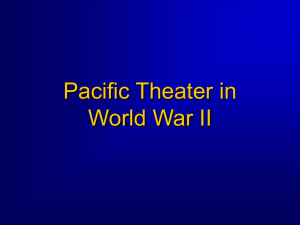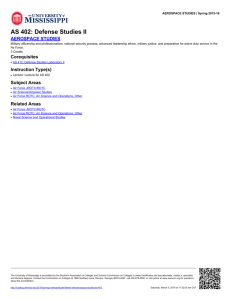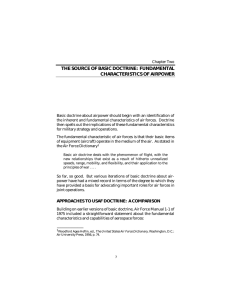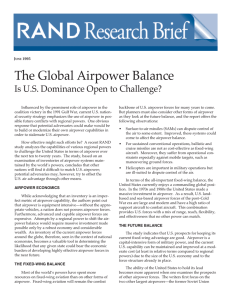AS 201 Fall 2005 Syllabus
advertisement
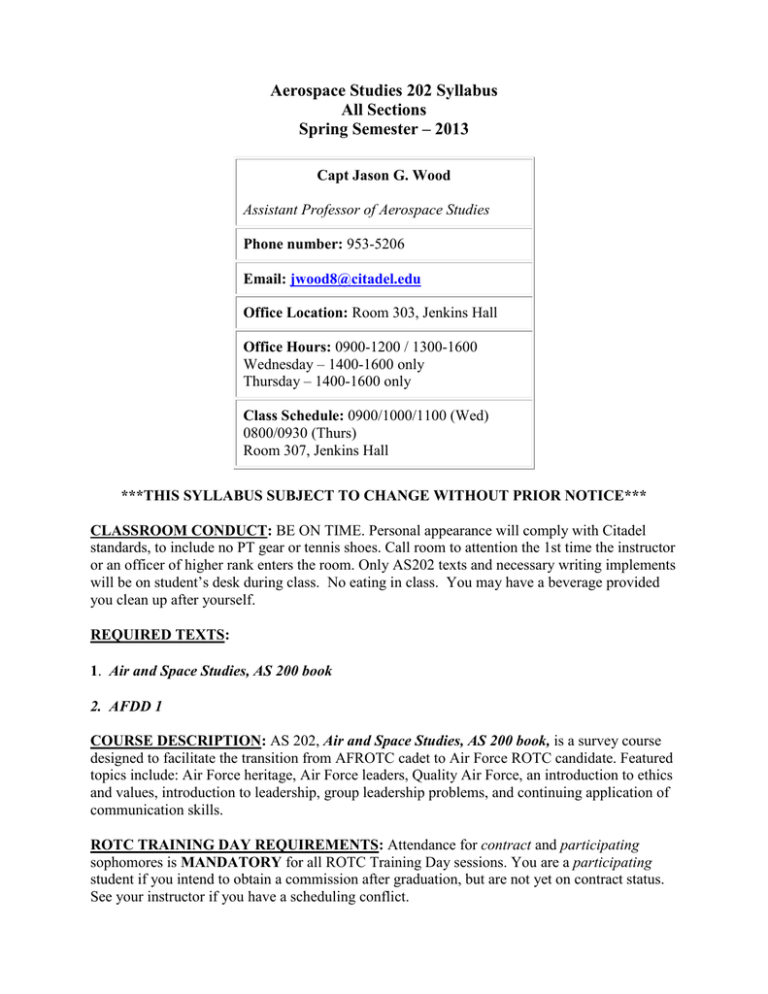
Aerospace Studies 202 Syllabus All Sections Spring Semester – 2013 Capt Jason G. Wood Assistant Professor of Aerospace Studies Phone number: 953-5206 Email: jwood8@citadel.edu Office Location: Room 303, Jenkins Hall Office Hours: 0900-1200 / 1300-1600 Wednesday – 1400-1600 only Thursday – 1400-1600 only Class Schedule: 0900/1000/1100 (Wed) 0800/0930 (Thurs) Room 307, Jenkins Hall ***THIS SYLLABUS SUBJECT TO CHANGE WITHOUT PRIOR NOTICE*** CLASSROOM CONDUCT: BE ON TIME. Personal appearance will comply with Citadel standards, to include no PT gear or tennis shoes. Call room to attention the 1st time the instructor or an officer of higher rank enters the room. Only AS202 texts and necessary writing implements will be on student’s desk during class. No eating in class. You may have a beverage provided you clean up after yourself. REQUIRED TEXTS: 1. Air and Space Studies, AS 200 book 2. AFDD 1 COURSE DESCRIPTION: AS 202, Air and Space Studies, AS 200 book, is a survey course designed to facilitate the transition from AFROTC cadet to Air Force ROTC candidate. Featured topics include: Air Force heritage, Air Force leaders, Quality Air Force, an introduction to ethics and values, introduction to leadership, group leadership problems, and continuing application of communication skills. ROTC TRAINING DAY REQUIREMENTS: Attendance for contract and participating sophomores is MANDATORY for all ROTC Training Day sessions. You are a participating student if you intend to obtain a commission after graduation, but are not yet on contract status. See your instructor if you have a scheduling conflict. ATTENDANCE POLICY United States Air Force Standard (AFROTCI 36-2017, 2.9.1). “Cadets must attend a minimum of 80 percent of scheduled AS classes to receive a passing final grade.” The Citadel, The Military College of S.C. (Academic Polices catalog issue pg. 25). “Absences, whether excused or unexcused, in excess of 20% of the meetings of a particular course can, at the discretion of the professor, result in a grade of “F” in the course.” STUDENTS WITH DISABILITIES: If you need accommodations because of a disability, please inform your instructor immediately and contact Dr. Jane Warner in 103 Thompson Hall or call 843-953-1820 to schedule an appointment. Her office is responsible for reviewing documentation provided by students requesting academic accommodations, and for accommodations planning in cooperation with students and instructors, as needed and consistent with course requirements. If your request for accommodations has already been approved and you have your accommodation letter, please see the instructor as soon as possible during office hours. GRADE COMPOSITION: 1. TESTS: Two tests will be given during the semester. These tests are mandatory. Each test counts for 25% of your final grade. Excused absences must be coordinated with the instructor at least 24 hours PRIOR TO the test time. Failure to show for the test or not coordinate an excused absence may result in a score of zero for the test. 2. QUIZZES: Random quizzes will be administered during the course to ensure students are prepared for class and reading the assigned material. The quizzes will account for 20% of your final grade. 2. COMMUNICATIONS SKILLS ASSIGNMENT: Each student will prepare and submit an Air Force official memorandum and talking paper. Both the memorandum and talking paper will be prepared in accordance with guidance in AFH 33-337, The Tongue and Quill These assignments will be worth 20% of your final grade. 3. CLASS PARTICIPATION: Class participation is worth 10% of your grade. Participation will be tracked, meaning a student can’t earn the full 10% if you don’t participate during the discussions or are absent from class. In accordance with Air Education and Training Command instructions, missing 20% of scheduled classes will result in your receiving a grade of "F" for the course. GRADING CRITERIA: Item / Activity 1. Test #1: Points 25 2. Test #2: 25 3. Quizzes 20 4. Communication Skills Assignment 20 5. Class Participation 10 Total 100 GRADING SCALE: 90.00 - 100 = A 80.00 – 89.99 = B 70.00 – 79.99 = C 60.00 – 69.99 = D 59.99 and below = F IMPORTANT DATES: WED THUR Exam #1 27 Feb 28 Feb Exam #2 24 Apr 25 Apr Communication Skills Assignment Due 17 Apr 18 Apr Class Participation Every Class Every Class Class Schedule Class/Dates/Lesson Wed 9 Jan Thur 10 Jan Lesson 1 Title Lesson Objective Assignments Lesson 1 Introduction to AS202 Know the AS200 course material and the course requirements Review syllabus Read student text, Chapter 1 Wed 16 Jan Thur 17 Jan Lesson 6 Airpower Through Cold War II Comprehend the impact airpower and other key events had on the USAF and US policy during the Cold War. Read student text, Chapter 14 W,R 23-24 Jan Airpower Through Cold War II Read student text, Chapter 15 W,R 30-31 Jan Airpower Through Cold War II Read student text, Chapter 16 W,R 6-7 Feb Airpower Through Cold War II W,R 13-14 Feb Lesson 7 Airpower in Post Cold War W,R 20-21 Feb Airpower in Post Cold War W,R 27-28 Feb Exam #1 W,R 6-7 Mar W,R 13-14 Mar W,R 20-21 Mar QUIZ #1 Communications topics due!!!!!!!!! Comprehend the key events of the Post Cold War Era and the impact of air and space power on the missions of that era. Read student text, Chapter 17 Read student text, Chapter 18 Read student text, Chapter 19 Exam #1 Airpower in Post Cold War Read student text, Chapter 20 Airpower in Post Cold War SPRING BREAK!!!! SPRING BREAK!!!! NO CLASS!!!! NO CLASS!!!! W,R 27-28 Mar Lesson 8 Air and Space Power Today Comprehend the background causes for the Global War on Terror (GWOT) and the importance of lessons learned from Operations ENDURING FREEDOM (OEF), IRAQI FREEDOM (OIF), and NEW DAWN. Read student text, Chapter 21 W,R 3-4 Apr Air and Space Power Today QUIZ #2 Read student text, Chapter 22 W,R 10-11 Apr Air and Space Power Today Read student text, Chapter 23 W,R 17-18 Apr Air and Space Power Today Note: Communication Skills Assignments Due W,R 24-25 Apr Exam #2 Exam #2 Note: Text book turn in AS202 SAMPLES OF BEHAVIOR Note: AERO 202 test questions are written directly from the following samples of behavior: Lesson 1: Introduction to AS 202 (Not Tested!) State the course objectives Describe course concepts (overview) Identify proper classroom conduct and procedures List student assignments and testing requirements Describe the course grading criteria Lesson 6: Airpower through the Cold War, Part II Explain the significance of the August 1964 Gulf of Tonkin Incident. Describe how airpower was used in Southeast Asia to interdict the Ho Chi Minh Trail (North Vietnamese supply routes into South Vietnam). Describe Rolling Thunder, Linebacker I, and Linebacker II bombing campaigns. Summarize the uses and the effectiveness of the B-52 in the Vietnam War. Give examples of the tactical airlift missions flown during the Vietnam War. Describe the US Air Force’s search and recovery mission in Vietnam. Summarize the lessons learned from the Vietnam War. Identify missile and aircraft systems developed after the Vietnam War. Lesson 7: Airpower in the Post Cold War State the US objectives of the Gulf War. List the objectives of the air campaign used in the Gulf War. Outline the key elements of Colonel Warden’s “INSTANT THUNDER” plan. Identify the four phases of the air campaign. Describe the significance of air and space power in the Gulf War. Give examples of key lessons learned from Operation PROVIDE COMFORT/NORTHERN WATCH, Operation SOUTHERN WATCH, the crisis in Somalia, and Operation DENY FLIGHT. Identify the three vital interests the United States and its NATO allies had at stake during the Kosovo crisis. State the five NATO objectives established in April 1999. State the three key strategic objectives of Operation ALLIED FORCE. 10. Explain the key lessons learned by the US military in Operation ALLIED FORCE.. Lesson 8: Air and Space Power Today List the major events leading to initiation of the GWOT. State the objectives of OEF according to the secretary of defense. Explain how air and space power has been used in the GWOT. Identify the emerging military lessons from the GWOT. Summarize the US national security lessons being learned from the GWOT.


